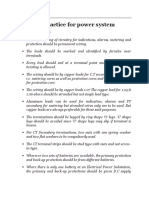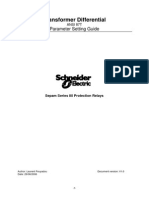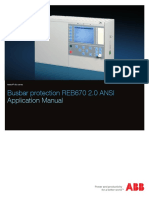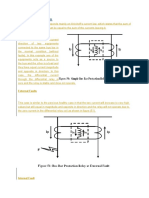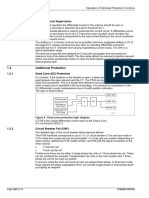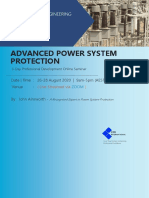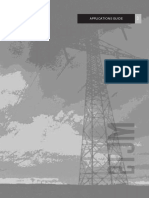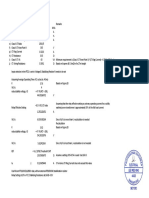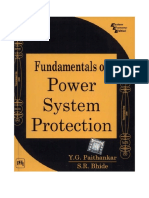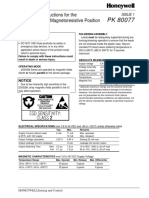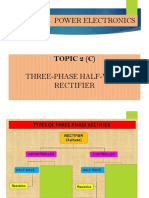Advanced
Power System
Protection
Dr Kashif Imran
Assistant Professor
USPCASE, NUST
�Busbar Protection
� Bus is derived from Latin word OMNIBUS (common for all)
Serves as nerve center of power system where various circuits are
connected together
Found in grid stations and supply panels
US Pak Centre for Advanced
Studies in Energy
1-What is a Busbar?
�2-Consequences and Causes of
Faults
over voltages.
lizards, snakes etc.
Weakening of insulation because of
ageing
Corrosion due to salty water
US Pak Centre for Advanced
Studies in Energy
A busbar has a high short circuit capacity
leads to enormous damage in case of fault
Breakdown of Insulation because of
�3-Why Busbar Protection?
Historically bus bars were left unprotected
Due to the increased voltage levels and higher short circuit
capacities it is no longer advisable to leave the busbar unprotected
by missing primary protection
US Pak Centre for Advanced
Studies in Energy
Due to low probability of Busbar faults
Because they were being provided backup protection by the protective
zones on either side
�4-Suitable Primry Protection?
Because terminals are physically near to each other
US Pak Centre for Advanced
Studies in Energy
Differential Protection. Why?
� Selection of CT
ratios
Selection of CT
ratios on the
basis of maximum
primary current
seen by the
individual feeder
is incorrect
Wrong Method
US Pak Centre for Advanced
Studies in Energy
5-Differential Protection of Busbar
�5-Differential Protection of Busbar
Correct Method
CT ratio for all CTs in Busbar Differential Scheme
=(primary current of that feeder which carries max current)/(1A or
5A)
US Pak Centre for Advanced
Studies in Energy
Selection of CT
ratios
�US Pak Centre for Advanced
Studies in Energy
6.1-Operation on Internal Faults
�6.2-Maloperation on External Faults
US Pak Centre for Advanced
Studies in Energy
Maloperation of CTs during external faults is caused
by the saturation of CTs carrying excessive primary
current
�7-Actual Behavior of Protective CT
Cts Primary Referred to the secondary side
Primary winding
leakage reactance referred
to secondary
Secondary winding
Resistance
Secondary winding
leakage reactance
US Pak Centre for Advanced
Studies in Energy
Primary winding Resistance
Referred to secondary
Core losses
Excitation
� At low values of Ip and therefore Is, EsIs*Zburden, is quite low.
Working flux will be low and, required magnetization current I o, will also be
low
Is is substantially equal to I p /N because of negligible Io, Is= (Ip /N)-Io
At higher values of Ip, before the knee of saturation curve, Is will initially
increase proportionate to Ip
Thus secondary induced volatge, E, also increases
Consequently Flux will be higher and, magnetization current I o, will be higher.
Is= (Ip /N)-Io , therefore due to huge I o, Is will be lowered
US Pak Centre for Advanced
Studies in Energy
7-Actual Behavior of Protective CT
�7-Actual Behavior of Protective CT
US Pak Centre for Advanced
Studies in Energy
Equivalent Circuit
�7-Actual Behavior of Protective CT
US Pak Centre for Advanced
Studies in Energy
After the knee point, any increase in flux requirement causes a
disproportionate increase in magnetizing current requirement
In case of saturation, Io no longer remains sinusoidal and becomes
peaky in nature
� As primary current goes on
increasing, at one stage
magnetizing requirement
becomes so large that there
is hardly any current for
burden.
This sate is known as
complete saturation
Secondary induced voltages
and currents are highly
distorted and consist of
sharp pulses near zero
crossings
US Pak Centre for Advanced
Studies in Energy
7-Actual Behavior of Protective CT
�8-Circuit model of saturated CT
US Pak Centre for Advanced
Studies in Energy
Magnetizing branch is modeled as short circuit when it saps all the
current
� Equivalent circuits
of CTs
Currents of
unsaturated CTs A
& B sum up
The resultant
current has two
paths
A high stabilizing
resistance in
series
Ensures that
current through
OC relay is below
pick up value,
US Pak Centre for Advanced
Studies in Energy
9-External fault with one saturated CT:
High Impedance Busbar Protection
�US Pak Centre for Advanced
Studies in Energy
10-Minimum Internal Fault that can be detected
by: High Impedance Busbar Protection
�US Pak Centre for Advanced
Studies in Energy
10.1-Equivalent Circuit
�11-Stability Ratio of High Impedance Busbar
Differential Scheme
The ratio of maximum external fault current for which scheme
remains stable to the minimum internal fault current for which it
operates
I
I f ,int ,min
The higher the value of stability S, the better is quality of differential
protection
Stability ratios of a few tens are common in extra high voltage
systems
US Pak Centre for Advanced
Studies in Energy
f , ext ,max
�US Pak Centre for Advanced
Studies in Energy
12-Supervisory Relay
�US Pak Centre for Advanced
Studies in Energy
13-Protection of a three phase Busbar
�US Pak Centre for Advanced
Studies in Energy
14-Problem
�US Pak Centre for Advanced
Studies in Energy
14-Problem


